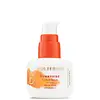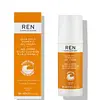What's inside
What's inside
 Key Ingredients
Key Ingredients

 Benefits
Benefits

 Concerns
Concerns

 Ingredients Side-by-side
Ingredients Side-by-side

Aloe Barbadensis Leaf Juice
Skin Conditioning3-O-Ethyl Ascorbic Acid
Skin ConditioningCaprylic/Capric Triglyceride
MaskingSimmondsia Chinensis Seed Oil
EmollientTetrahexyldecyl Ascorbate
AntioxidantTranexamic Acid
AstringentCaprylyl Caprylate/Caprate
EmollientGlycerin
HumectantNiacinamide
SmoothingIsomalt
HumectantVitis Vinifera Seed Oil
EmollientGlyceryl Stearate
EmollientCetearyl Glucoside
EmulsifyingGlutathione
Tremella Fuciformis Sporocarp Extract
AntioxidantInonotus Obliquus Extract
Skin ConditioningSodium PCA
HumectantTocopherol
AntioxidantWater
Skin ConditioningCitric Acid
BufferingCetyl Alcohol
EmollientPhytol
EmollientBenzyl Alcohol
PerfumingHydroxyethylcellulose
Emulsion StabilisingDehydroacetic Acid
PreservativeBenzoic Acid
MaskingSorbic Acid
PreservativeMaltodextrin
AbsorbentDisodium Phosphate
BufferingPolysorbate 60
EmulsifyingSodium Phosphate
BufferingAloe Barbadensis Leaf Juice, 3-O-Ethyl Ascorbic Acid, Caprylic/Capric Triglyceride, Simmondsia Chinensis Seed Oil, Tetrahexyldecyl Ascorbate, Tranexamic Acid, Caprylyl Caprylate/Caprate, Glycerin, Niacinamide, Isomalt, Vitis Vinifera Seed Oil, Glyceryl Stearate, Cetearyl Glucoside, Glutathione, Tremella Fuciformis Sporocarp Extract, Inonotus Obliquus Extract, Sodium PCA, Tocopherol, Water, Citric Acid, Cetyl Alcohol, Phytol, Benzyl Alcohol, Hydroxyethylcellulose, Dehydroacetic Acid, Benzoic Acid, Sorbic Acid, Maltodextrin, Disodium Phosphate, Polysorbate 60, Sodium Phosphate
Water
Skin ConditioningGlycerin
HumectantCetearyl Ethylhexanoate
EmollientLauryl Laurate
Skin ConditioningCetearyl Alcohol
EmollientTapioca Starch
Ascorbyl Glucoside
AntioxidantHydroxyacetophenone
AntioxidantCarbomer
Emulsion StabilisingPhenoxyethanol
PreservativeCetearyl Glucoside
EmulsifyingMannitol
HumectantFaex Extract
Skin ConditioningCitrus Grandis Peel Oil
MaskingHippophae Rhamnoides Oil
EmollientParfum
MaskingCitrus Aurantium Dulcis Flower Oil
AstringentTocopherol
AntioxidantCitrus Nobilis Peel Oil
MaskingCitrus Tangerina Peel Oil
MaskingDiglucosyl Gallic Acid
Glycogen
HumectantMagnesium Ascorbyl Phosphate
AntioxidantAmmonium Bicarbonate
BufferingGlucose
HumectantHelianthus Annuus Seed Oil
EmollientRosmarinus Officinalis Leaf Extract
AntimicrobialSodium Hydroxide
BufferingCitral
PerfumingLimonene
PerfumingLinalool
PerfumingWater, Glycerin, Cetearyl Ethylhexanoate, Lauryl Laurate, Cetearyl Alcohol, Tapioca Starch, Ascorbyl Glucoside, Hydroxyacetophenone, Carbomer, Phenoxyethanol, Cetearyl Glucoside, Mannitol, Faex Extract, Citrus Grandis Peel Oil, Hippophae Rhamnoides Oil, Parfum, Citrus Aurantium Dulcis Flower Oil, Tocopherol, Citrus Nobilis Peel Oil, Citrus Tangerina Peel Oil, Diglucosyl Gallic Acid, Glycogen, Magnesium Ascorbyl Phosphate, Ammonium Bicarbonate, Glucose, Helianthus Annuus Seed Oil, Rosmarinus Officinalis Leaf Extract, Sodium Hydroxide, Citral, Limonene, Linalool
 Reviews
Reviews

Ingredients Explained
These ingredients are found in both products.
Ingredients higher up in an ingredient list are typically present in a larger amount.
Cetearyl Glucoside is a surfactant and emulsifier. It can be produced from synthetic of natural sources of cetearyl alcohol and glucose.
Emulsifiers help prevent ingredients from separating, such as oils and waters. It can also be used to enhance the texture of products.
As a surfactant, Cetearyl Glucoside helps during the cleansing process. By gathering all the dirt and oils, it allows these molecules to be washed away easily.
Learn more about Cetearyl GlucosideGlycerin is already naturally found in your skin. It helps moisturize and protect your skin.
A study from 2016 found glycerin to be more effective as a humectant than AHAs and hyaluronic acid.
As a humectant, it helps the skin stay hydrated by pulling moisture to your skin. The low molecular weight of glycerin allows it to pull moisture into the deeper layers of your skin.
Hydrated skin improves your skin barrier; Your skin barrier helps protect against irritants and bacteria.
Glycerin has also been found to have antimicrobial and antiviral properties. Due to these properties, glycerin is often used in wound and burn treatments.
In cosmetics, glycerin is usually derived from plants such as soybean or palm. However, it can also be sourced from animals, such as tallow or animal fat.
This ingredient is organic, colorless, odorless, and non-toxic.
Glycerin is the name for this ingredient in American English. British English uses Glycerol/Glycerine.
Learn more about GlycerinTocopherol (also known as Vitamin E) is a common antioxidant used to help protect the skin from free-radicals and strengthen the skin barrier. It's also fat soluble - this means our skin is great at absorbing it.
Vitamin E also helps keep your natural skin lipids healthy. Your lipid skin barrier naturally consists of lipids, ceramides, and fatty acids. Vitamin E offers extra protection for your skin’s lipid barrier, keeping your skin healthy and nourished.
Another benefit is a bit of UV protection. Vitamin E helps reduce the damage caused by UVB rays. (It should not replace your sunscreen). Combining it with Vitamin C can decrease sunburned cells and hyperpigmentation after UV exposure.
You might have noticed Vitamin E + C often paired together. This is because it is great at stabilizing Vitamin C. Using the two together helps increase the effectiveness of both ingredients.
There are often claims that Vitamin E can reduce/prevent scarring, but these claims haven't been confirmed by scientific research.
Learn more about TocopherolWater. It's the most common cosmetic ingredient of all. You'll usually see it at the top of ingredient lists, meaning that it makes up the largest part of the product.
So why is it so popular? Water most often acts as a solvent - this means that it helps dissolve other ingredients into the formulation.
You'll also recognize water as that liquid we all need to stay alive. If you see this, drink a glass of water. Stay hydrated!
Learn more about Water